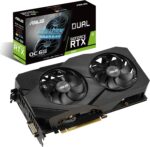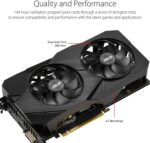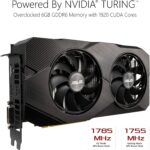






ASUS TUF Gaming GeForce RTX 2060 OC Edition 6GB GDDR6 Graphics Card Price in Pakistan
₨60,000 Original price was: ₨60,000.₨54,500Current price is: ₨54,500.
- Digital Max Resolution:7680 x 4320
- Powered by NVIDIA Turing with 1785 MHz Boost Clock, 1920 CUDA cores, and overclocked 6GB GDDR6 memory
- Supports up to 4 monitors with DisplayPort 1. 4, HDMI 2. 0 and DVI ports
- Wing-Blade Fans boast IP5X dust-resistance and operate at 0 dB levels when temperatures hit below 55 °C. Avoid using unofficial software
- Protective Backplate features a durable aluminum construction to prevent PCB flex and trace damage.
- GPU Tweak II makes monitoring performance and streaming in real time easier than ever, and includes additional software like Game Booster, XSplit Gamecaster, WTFast, and QuantumCloud
16 in stock
ASUS TUF Gaming GeForce RTX 2060 OC Edition 6GB GDDR6 Graphics Card Price in Pakistan
ASUS Dual GeForce RTX 2060 EVO (6GB): The Complete, No-Nonsense Buyer’s Guide
We take an unflinching, practical look at the ASUS Dual GeForce RTX 2060 EVO (6GB): what it is, who it’s for, and how to get the most from it today. From Turing RT and Tensor cores to Axial-tech cooling, NVENC for creators, and real-world installation tips, we cover every angle so you can make a confident decision.
Overview: What the ASUS Dual GeForce RTX 2060 EVO 6GB Brings to the Table
The ASUS Dual GeForce RTX 2060 EVO (6GB) is a Turing-based graphics card designed for smooth 1080p gaming with the added benefits of hardware ray tracing and AI-assisted upscaling. It marries NVIDIA’s RTX 2060 GPU (TU106)—featuring 1,920 CUDA cores and 6GB of GDDR6 on a 192-bit bus—with ASUS’s Axial-tech dual-fan cooler, 0dB fan stop under light loads, and Auto-Extreme manufacturing. That combo aims to keep temperatures reined in and acoustics low while delivering the performance uplift Turing is known for, including DLSS Super Resolution support.

ASUS TUF Gaming GeForce RTX 2060 OC Edition 6GB GDDR6 Graphics Card Price in Pakistan
Who it’s for:
• Gamers targeting high-refresh 1080p in popular titles, willing to mix high/medium settings when ray tracing is involved.
• Creators and streamers who want reliable NVENC encoding and CUDA acceleration without jumping to newer, pricier GPUs.
• Builders who value quiet cooling, a sturdy backplate, and sane power requirements.
Why the Dual EVO model:
ASUS’s Dual series focuses on substance over flair—clean shroud, robust cooler, and practical I/O that includes DVI-D for older panels. It aims squarely at builds where reliability and fit matter more than RGB everything.
Key Specifications at a Glance (With Context That Matters)
Core hardware
- GPU: NVIDIA TU106 (Turing) with 1,920 CUDA cores; Boost ~1,680 MHz reference (varies per board/BIOS).
- Memory: 6GB GDDR6, 14 Gbps, 192-bit, 336 GB/s bandwidth.
- Ray Tracing / AI: RT Cores + Tensor Cores enable ray-traced effects and DLSS Super Resolution.
ASUS Dual EVO specifics
- Slots/Size: 2.5-slot design; 242 × 130 × 53 mm (9.53″ × 5.12″ × 2.09″). Check case & adjacent slot clearance.
- Power: 1× 8-pin PCIe; 500 W PSU recommended. Typical board power class for 2060 is ~160 W.
- I/O: 1× DisplayPort 1.4, 2× HDMI 2.0b, 1× DVI-D; up to 4 displays.
- Features: Axial-tech fans, 0dB mode, aluminum backplate, Auto-Extreme manufacturing, GPU Tweak II software.
What that means for you:
• 1080p first. The 2060 excels at 1080p with quality settings pushed high, dipping to balanced presets when enabling ray tracing.
• Memory headroom. 6GB is fine for most esports and many AAA titles at 1080p; expect to tune textures in a few vRAM-heavy games.
• Ports for every era. The DVI-D port keeps that older 1080p/144Hz panel alive while DisplayPort 1.4 handles newer high-refresh displays.
Inside Turing: RT Cores, Tensor Cores, and Why They Still Matter
Turing brought hardware ray tracing to mainstream GPUs with dedicated RT Cores accelerating BVH traversal and ray-triangle intersections—features that make realistic shadows, reflections, and global illumination feasible. Tensor Cores fuel DLSS Super Resolution, using AI models to upscale and denoise images rendered at lower resolutions, improving performance while preserving fine detail. On RTX 2060, that translates to playable ray-traced visuals at 1080p when combined with DLSS and sensible presets.

ASUS TUF Gaming GeForce RTX 2060 OC Edition 6GB GDDR6 Graphics Card Price in Pakistan
Key takeaways
- RT Cores: Enable ray-traced effects at practical settings.
- Tensor Cores: DLSS 2.x works on all RTX cards, including 2060; DLSS Frame Generation (DLSS 3/4) requires newer architectures.
- Future-proofing, realistically: While new features evolve, DLSS Super Resolution remains a long-lived performance lever on RTX 20-series.
Cooling Deep Dive: Dual Axial-Tech Fans, 0dB Logic, and Heatsink Design
ASUS’s Axial-tech fans use a smaller hub to support longer blades and a barrier ring to focus airflow downward through the fin stack. In light loads, 0dB logic stops fans below a temperature threshold (about 55°C), resuming automatically as the GPU warms—handy for quiet desktops and media playback. The 2.5-slot fin stack spreads heat over a larger area, easing fan RPM and reducing tonal noise. An aluminum backplate adds rigidity and a touch of passive heat spreading.
Why it feels quieter in practice
- Lower static-pressure requirement: Axial-tech geometry and fin density work together, so fans don’t need to howl.
- Dead-silent idle: 0dB eliminates idle whirr; case fans become the audible floor.
Power, Thermals, and Acoustics: Balancing Heat, Noise, and Headroom
Typical power draw for RTX 2060 boards sits near ~160 W under gaming loads; ASUS recommends a 500 W PSU to leave margin for CPU spikes, drives, and fans. With reasonable case airflow, the Dual EVO’s cooler keeps temperatures in check without high RPM. For small-to-mid tower builds, plan exhaust close to the GPU to avoid heat recirculation.
Practical tuning notes
- Custom fan curve: A gentle ramp prevents sudden tonal shifts without sacrificing temps.
- Undervolting: Shaving 25–50 mV can trim a few degrees and dBA with negligible performance loss.
- Thermal paste age: If you purchased used, a paste refresh after years of service can restore delta-T and reduce noise.
Design & Build Quality: Protective Backplate, Auto-Extreme, and Materials
The aluminum backplate counters PCB flex and protects traces, especially useful when moving systems or during install. ASUS’s Auto-Extreme manufacturing—an automated soldering and assembly process—aims to reduce solder strain and human variability across batches. The shroud is purposefully minimal: subdued branding, no RGB, fewer distraction points in a tempered-glass build.
Durability highlights
- Rigid structure: Backplate + steel bracket minimize sag.
- Consistency: Auto-Extreme is designed to improve lot-to-lot reliability.
- Serviceability: Standard 1× 8-pin connection, accessible screws, and conventional fin orientation simplify cleaning.
Ports & Multi-Display: HDMI, DisplayPort, DVI-D—Plus 4-Monitor Setups
You get 1× DisplayPort 1.4, 2× HDMI 2.0b, and 1× DVI-D, supporting up to four displays at once and a max digital resolution of 7680×4320. That’s flexible for triple-monitor racing sims, creator timelines, or a blend of new and old panels (DVI-D saves adapters). The DP 1.4 port handles high-refresh 1080p/1440p with adaptive sync on compatible monitors.
Connectivity tips
- High-refresh 1080p: Prefer DisplayPort for best compatibility and bandwidth.
- Legacy monitors: The DVI-D port supports many 1080p/144Hz panels; check your display’s mode table.
- Cable sanity: Quality VESA-certified DP cables avoid intermittent flicker at high refresh.
Installation & Compatibility: Case Fit, Slot Clearance, and PSU Guidance
The card measures ~242 × 130 × 53 mm and occupies 2.5 slots—plan to leave the adjacent slot open for airflow. Most mATX and ATX cases handle this length easily; compact ITX cases should confirm GPU length limits against 242 mm. A single 8-pin power lead suffices; route it cleanly to avoid fan fouling. 500 W PSU is the conservative recommendation; quality 450 W units can be viable with efficient CPUs, but we favor headroom.
Pre-flight checks
- Measure from the rear PCIe bracket to front fans/radiators to ensure the full 242 mm clears fittings.
- Confirm motherboard slot spacing; leave breathing room below the GPU.
- Update BIOS if your board is older; GOP/fast-boot quirks occasionally surface with GPU swaps.
1080p Gaming Today: Practical Settings That Feel Great
At 1080p, this card shines in esports (very high FPS with competitive settings) and handles most AAA titles well with high or balanced presets. For newer games, we suggest turning on DLSS Quality (when available) and easing a few heavy toggles (e.g., contact shadows, volumetrics) to maintain smooth frame pacing. Ray tracing is viable at 1080p with judicious presets and DLSS; more on that next.
Quality-of-life tweaks
- Cap FPS to your monitor’s refresh rate + adaptive sync to reduce input latency variability.
- Pre-rendered frames: Use NVIDIA Reflex when supported; it trims system latency noticeably.
Ray Tracing & DLSS on RTX 2060: Sensible Targets and Tweaks
DLSS 2.x is supported on RTX 2060, delivering meaningful uplift while keeping image quality crisp. Start with DLSS Quality at 1080p; move to Balanced if a game’s RT workload is heavier. Frame Generation (DLSS 3/4) isn’t available on Turing; it requires newer architectures, but Super Resolution remains the core win here. Enable RT shadows/reflections at medium in demanding games to keep frame times even.
Tuning checklist
- DLSS Quality first; if frame time spikes persist, drop RT one notch before stepping DLSS to Balanced.
- Sharpening: Moderate in-engine sharpening helps counter softer edges from upscaling.
Creators’ Corner: Turing NVENC, CUDA Acceleration, and App Tips
Turing introduced a significantly improved NVENC encoder over Pascal, enabling high-quality H.264/HEVC streaming and capture with lower CPU usage—ideal for OBS Studio and NLE background exports. With CUDA, apps like Adobe Premiere Pro, DaVinci Resolve, Blender, and Topaz tools accelerate timelines, filters, denoising, and renders. For HEVC, Turing NVENC supports B-frames (except TU117), improving compression efficiency versus older generations.
Creator presets that work
- OBS: 1080p60, NVENC (new), CQ/ICQ mode; test P5/P6 quality levels; set a capped max bitrate for platform compliance.
- Premiere/Resolve: GPU decode/encode where supported; keep VRAM headroom by avoiding unnecessary UHD proxies if your timeline is 1080p.
Drivers & Software: NVIDIA Support, ASUS GPU Tweak II, and Profiles
NVIDIA continues to publish Game Ready Drivers for RTX GPUs, and maintains Vulkan support on Windows and Linux. Use ASUS GPU Tweak II to monitor temps, set fan curves, and create silent or gaming profiles. As of recent policy updates, NVIDIA is maintaining GRD support for RTX architectures through the Windows 10 lifecycle extension, while older GTX 700/900/10 cards approach GRD sunset later in 2025.

ASUS TUF Gaming GeForce RTX 2060 OC Edition 6GB GDDR6 Graphics Card Price in Pakistan
Setup pointers
- Clean install via the NVIDIA App/installer to avoid legacy profiles colliding.
- Per-game profiles: Tweak texture filtering and low-latency mode only where they actually help.
Overclocking & Undervolting: Safe Gains, Saner Temps
The Dual EVO cooler offers room for mild overclocks while staying comfortable acoustically. Push +50 to +100 MHz on the core and +500 MHz (effective) on memory as a starting point, validating with long-form gameplay rather than just synthetic runs. If your priority is noise and temps, undervolting can be more impactful: flatten the voltage/frequency curve to sustain near-stock clocks at lower mV, trimming a few dBA. Keep an eye on VRAM temps and hotspot metrics.
Golden rules
- Stability beats peak scores. Favor settings that are quiet and crash-free across multiple titles.
- One change at a time. Track temps and performance deltas to avoid chasing ghosts.
Upgrades & Alternatives: 12GB Variant, Used Market, and New-Gen Context
ASUS also offers a Dual RTX 2060 EVO 12GB variant with 2,176 CUDA cores, 12GB GDDR6, and a 2.7-slot cooler—useful if you juggle heavier textures or content creation workloads that benefit from more VRAM. If your library skews toward ultra-high-res texture packs, it’s a safer bet. On the used market, verify fan health, artifact-free output, and operating temps under load. For brand-new purchases, compare pricing against newer cards when deals surface.
When to prefer the 12GB model
- You edit 4K timelines or run heavy AI filters.
- You install HD texture mods and want fewer compromises.
VR & Streaming: Smooth Captures, Stable Sessions
With NVENC offloading encode, you can stream to Twitch/YouTube while gaming with minimal CPU hit. For VR, stick to asynchronous reprojection defaults, keep supersampling reasonable, and enable motion smoothing as needed. Use DisplayPort for most modern headsets; check your HMD’s cable spec and GPU port map to avoid adapters mid-chain.
Streaming checklist
- Adaptive bitrate only if your platform supports it; otherwise use a safe, constant setting.
- Record locally to a separate drive if you’re capturing long sessions.
Troubleshooting & Maintenance: Dust, Drivers, and Diagnostics
If temps creep up, dust is almost always the culprit: clean the heatsink from the exhaust side using short air bursts; hold the fans to protect bearings. Driver hiccups after a major OS update? Perform a clean driver install. Random black screens at high refresh are commonly cable-related—swap to a certified DP cable before chasing firmware updates. Artifacting under load can indicate unstable OC, aging thermal paste, or power delivery issues; revert to stock and test.
Preventive care
- Quarterly dusting in dusty environments.
- Annual paste/pad refresh if the card runs hot or you bought used.
- Log temps with a lightweight overlay; trends matter more than a single number.
Value Analysis: Total Platform Cost, Longevity, and Resale
The Dual RTX 2060 EVO (6GB) remains a sensible 1080p workhorse when priced appropriately, particularly for mixed gaming + creation use. Factor total platform: if your CPU is mid-range and your monitor is 1080p/144Hz, this card aligns well. Resale remains decent thanks to NVENC/CUDA utility and DLSS 2.x support. If your budget creeps into the price band of newer GPUs, weigh warranty length, VRAM size, and driver feature trajectory before deciding.

ASUS TUF Gaming GeForce RTX 2060 OC Edition 6GB GDDR6 Graphics Card Price in Pakistan
Sustainable Build Ideas: Efficiency Without the Lecture
Small changes stack up:
- Undervolt to shave 5–15 W during gaming, cutting heat and noise.
- Use case fan curves tied to GPU temps (not CPU) for smarter airflow.
- Prefer balanced presets + DLSS Quality over brute-force native ultra—better efficiency, indistinguishable visuals at desk distance.
Common Comparisons: RTX 2060 vs 2060 Super, GTX 1660 Ti, RTX 3060
RTX 2060 vs 2060 Super
- Super adds cores and a 256-bit bus, helpful at higher resolutions and heavier RT loads. If pricing is close on the used market, Super is the more relaxed 1080p/1440p option.
RTX 2060 vs GTX 1660 Ti
- 1660 Ti lacks RT/Tensor cores. For pure raster at 1080p, they can trade blows; once DLSS or ray tracing enters the chat, 2060 pulls ahead.
RTX 2060 vs RTX 3060
- 3060 (12GB) brings newer architecture and more VRAM; worth it if the price gap is modest and you plan to play texture-heavy titles or create with big frame buffers.
Verdict: Who Should Buy the ASUS Dual RTX 2060 EVO (6GB) Right Now
Choose the ASUS Dual RTX 2060 EVO (6GB) if you want a quiet, capable 1080p card with DLSS 2.x and NVENC for occasional streaming or editing, and you value solid thermals plus practical I/O (that DVI-D port still saves builds). If you frequently install VRAM-hungry texture packs or edit 4K with heavy effects, consider the 12GB 2060 EVO or step to a newer generation when pricing aligns. For balanced, everyday gaming with a professional-leaning feature set, this Dual EVO still makes a strong case.
ASUS TUF Gaming GeForce RTX 2060 OC Edition 6GB GDDR6 Graphics Card Price in Pakistan – Limited Offer
Direct Order to PPG Buy & Sell Admin
FAQs
1) Does the ASUS Dual RTX 2060 EVO (6GB) support DLSS and ray tracing out of the box?
Yes. The RTX 2060 includes RT and Tensor cores, enabling ray tracing and DLSS 2.x Super Resolution on day one. DLSS Frame Generation (DLSS 3/4) is available only on newer RTX architectures.
2) How many monitors can I run and which ports should I use?
You can connect up to four displays via 1× DisplayPort 1.4, 2× HDMI 2.0b, and 1× DVI-D. Use DisplayPort for high-refresh 1080p/1440p panels; the DVI-D port is handy for legacy monitors.
3) What power supply do I need and how many connectors?
ASUS recommends a 500 W PSU. The card uses one 8-pin PCIe power connector; always ensure the PSU is a reputable model with sufficient 12V amperage.
4) Will NVIDIA keep supporting the RTX 2060 with new drivers?
Yes—RTX GPUs continue to receive Game Ready Drivers and API support (e.g., Vulkan). NVIDIA recently outlined end-of-support timelines for older GTX series, while maintaining GRD support for RTX under Windows 10 for an extended period.
5) Is the 12GB version worth it over the 6GB model?
If you regularly use VRAM-heavy settings, texture mods, or creator workflows with large frame buffers, the 12GB model’s extra memory and cores help. For focused 1080p gaming with moderate textures, the 6GB Dual EVO remains a strong value.
Product Specifications
| GPU | NVIDIA GeForce RTX 3090 |
|---|---|
| CUDA Cores | 10,496 |
| Boost Clock | 1,755 MHz (OC) |
| Memory | 24 GB GDDR6X, 384-bit, 19.5 Gbps |
| Memory Bandwidth | 936 GB/s |
| Interface | PCIe 4.0 x16 |
| Display Outputs | 3× DisplayPort 1.4a, 2× HDMI 2.1 |
| Max Resolution | 8K @ 60 Hz |
| SLI Support | 2-way NVLink |
| Cooling | WINDFORCE 3X (2×90 mm + 1×80 mm fans, alternate spinning, Screen Cooling, large copper heat pipes) |
| Features | RGB Fusion 2.0, Metal Backplate, Dual BIOS, 4-Year Warranty (w/ registration), NVLink, Durability-enhanced PCB |
| Power Connectors | 2× 8-pin PCIe |
| TDP | 350 W |
| Recommended PSU | 750 W |
| Dimensions | ~320 × 129 × 57 mm (L×H×W), 3-slot width |
| Brand |
ASUS |
|---|


MAECENAS IACULIS
Vestibulum curae torquent diam diam commodo parturient penatibus nunc dui adipiscing convallis bulum parturient suspendisse parturient a.Parturient in parturient scelerisque nibh lectus quam a natoque adipiscing a vestibulum hendrerit et pharetra fames nunc natoque dui.
ADIPISCING CONVALLIS BULUM
- Vestibulum penatibus nunc dui adipiscing convallis bulum parturient suspendisse.
- Abitur parturient praesent lectus quam a natoque adipiscing a vestibulum hendre.
- Diam parturient dictumst parturient scelerisque nibh lectus.
Scelerisque adipiscing bibendum sem vestibulum et in a a a purus lectus faucibus lobortis tincidunt purus lectus nisl class eros.Condimentum a et ullamcorper dictumst mus et tristique elementum nam inceptos hac parturient scelerisque vestibulum amet elit ut volutpat.
Related products
GIGABYTE GeForce RTX 3090 GAMING OC 24G Graphic Card Price in Pakistan – Limited Offer
GIGABYTE GeForce RTX 3090 GAMING OC 24G — Key Specs
- GPU: NVIDIA GeForce RTX 3090 (Ampere architecture)
- CUDA Cores: 10,496
- Boost Clock: Factory overclocked (up to 1755 MHz)
- Memory: 24GB GDDR6X, 384-bit interface
- Memory Speed: 19.5 Gbps
- Cooling System: WINDFORCE 3X with alternate spinning fans, copper plate & 7 heat pipes
- Power Connectors: 2 × 8-pin
- Recommended PSU: 850W
- Display Outputs: 3 × DisplayPort 1.4a, 2 × HDMI 2.1
- Slot Size: 2.5–3 slots, with metal backplate for reinforcement
- Key Features: Dual BIOS (OC/Silent), RGB Fusion 2.0, AORUS Engine software, NVLink support
MSI GeForce RTX 5060 Ti 16G VENTUS 2X PLUS Graphic Card Price in Pakistan – Limited Offer
MSI GeForce RTX 5060 Ti 16G Ventus 2X Plus — Key Specs
- GPU Architecture: NVIDIA Blackwell
- CUDA Cores: 4608
- Memory: 16GB GDDR7, 28 Gbps, 128-bit bus
- Boost Clock: Up to 2587 MHz (Extreme Performance via MSI Center)
- Ray Tracing Cores: 4th Gen RT
- Tensor Cores: 5th Gen (DLSS 4 support)
- Power Consumption (TDP): ~180 W
- Power Connector: 1× 8-pin PCIe
- Recommended PSU: 600 W
- Interface: PCI Express Gen 5.0 ×16
- Outputs: 3× DisplayPort 1.4a, 1× HDMI 2.1a (HDCP 2.3, up to 4 displays)
- Encoder/Decoder: 9th Gen NVENC with AV1 support
- Dimensions: 227 × 126 × 41 mm
- Slot Size: Dual-slot design
- Cooling: Dual-fan (MSI Ventus 2X Plus)
MSI GeForce RTX 5060 Ti VENTUS 2X 8G OC PLUS Graphics Card Price in Pakistan – Limited Offer
- Powered by the NVIDIA Blackwell architecture and DLSS 4
- Core Clock: Extreme Performance: 2617 MHz (MSI Center)
- Boost: 2602 MHz
- STORMFORCE FAN: Seven fan blades, claw texturing, and a circular arc are designed for optimal airflow with minimal noise.
- Heat Pipes are designed for efficient heat transfer; they effectively draw thermal energy away from the GPU, improving overall cooling performance.
- Reinforcing Backplate: The reinforcing backplate features an airflow vent that allows exhaust air to directly pass through.
- MSI Center: The exclusive MSI Center software lets you monitor, tweak, and optimize MSI products in real-time.
- Afterburner software takes full control with the most recognized and widely used graphics card overclocking software in the world.
MSI GeForce RTX 5060 VENTUS 2X 8G OC WHITE Graphics Card Price in Pakistan – Limited Offer
- Powered by the NVIDIA Blackwell architecture and DLSS 4
- Core Clocks: Extreme Performance: 2535 MHz (MSI Centre)
- Boost: 2527 MHz
- TORX Fan 5.0: Fan blades linked by ring arcs work to stabilise and maintain high-pressure airflow.
- Heat Pipes are designed for efficient heat transfer; they effectively draw thermal energy away from the GPU, improving overall cooling performance.
- Reinforcing Backplate: The reinforcing backplate features an airflow vent that allows exhaust air to directly pass through.
- MSI Centre: The exclusive MSI Centre software lets you monitor, tweak and optimise MSI products in real-time.
- Afterburner software takes full control with the most recognised and widely used graphics card overclocking software in the world.


















Reviews
There are no reviews yet.